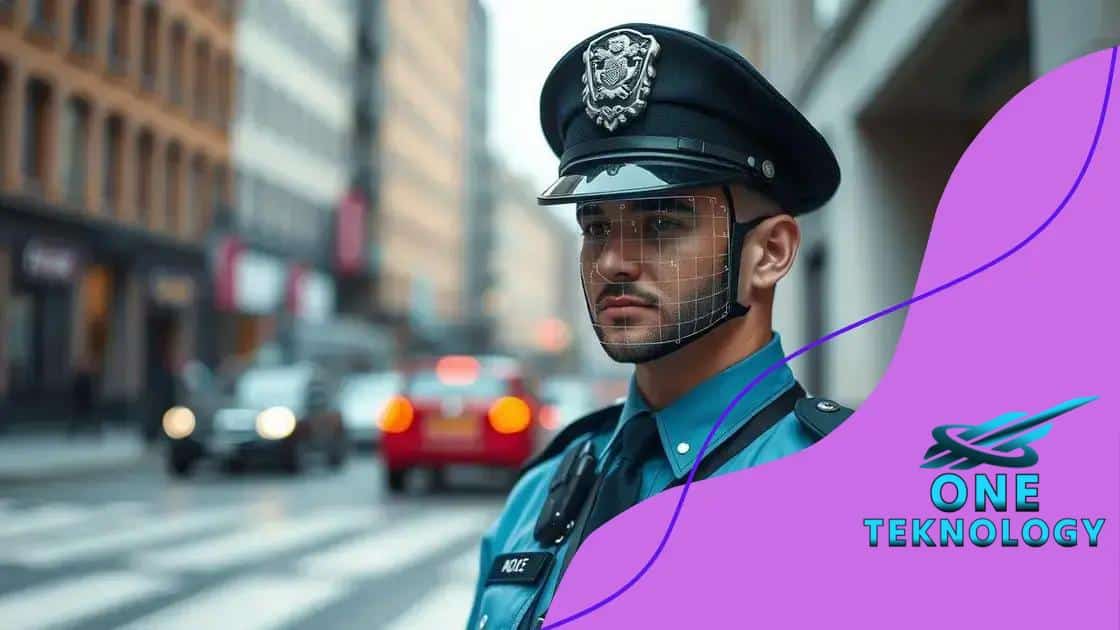The role of facial recognition in enhancing public safety

The role of facial recognition in enhancing public safety is pivotal, as it enables quick identification of individuals, aids law enforcement in crime prevention, and streamlines security processes across various sectors.
The role of facial recognition in enhancing public safety is becoming increasingly significant. Have you ever wondered how this technology impacts your daily life and community safety? Let’s explore its multifaceted applications.
Understanding facial recognition technology
Understanding facial recognition technology is crucial in today’s security landscape. This technology uses advanced algorithms to identify and verify individuals based on their facial features. By analyzing the patterns of a person’s face, it can match this data against a vast database of images.
This process begins with capturing an image, which can be done using various devices like smartphones or security cameras. Once the facial data is collected, the software extracts features like the distance between the eyes, nose shape, and chin structure. These characteristics create a unique facial signature, enabling recognition.
How Facial Recognition Works
The workings of facial recognition involve several key steps:
- Image capture: Photos or video sequences are taken using cameras.
- Preprocessing: The captured image is adjusted for factors like lighting and angle.
- Feature extraction: Distinct facial features are identified and mapped.
- Comparison: The features are compared to those in a database for matching.
The accuracy of this technology can vary depending on various factors, including the quality of the image and the lighting conditions at the time of capture. While generally effective, facial recognition systems can sometimes misidentify individuals due to these variables. Safety measures are continuously being improved to enhance reliability and accuracy.
Applications of Facial Recognition
Facial recognition is utilized in a range of fields, including security, banking, and social media. For example, law enforcement agencies can use this technology to identify suspects in crime scenes by matching faces captured in surveillance footage. In banking, it helps in verifying a user’s identity during transactions, adding an extra layer of security.
This technology is also prevalent in social media, where platforms use automated tagging to recognize users in photos. As this technology evolves, it promises to create more secure environments while also sparking essential discussions about privacy and ethics.
How facial recognition improves crime prevention
Facial recognition technology plays a vital role in how we enhance public safety. By leveraging advanced algorithms, it significantly improves crime prevention efforts for law enforcement agencies. This technology allows officers to quickly identify suspects, which can deter criminal activity.
One of the primary ways that facial recognition aids in crime prevention is through real-time monitoring. Surveillance cameras equipped with this technology can scan crowds and match faces against wanted lists. This capability enables quicker responses to potential threats.
Key Benefits of Facial Recognition in Crime Prevention
Facial recognition offers several advantages:
- Rapid Identification: Law enforcement can swiftly identify individuals with criminal backgrounds.
- Increased Security: Public areas like airports and train stations become safer with surveillance.
- Deterrent Effect: Knowing that facial recognition technology is in use may discourage potential criminals.
- Evidence Gathering: Provides crucial evidence that can be used in investigations and court cases.
This technology is not just limited to urban areas. Many small towns and municipalities are adopting these systems to manage public safety more effectively. By doing so, they can ensure a quicker response to incidents before they escalate.
Case Studies and Real-World Examples
Several cities have reported positive results from implementing facial recognition systems. For instance, in specific metropolitan areas, law enforcement has documented a noticeable decrease in theft and assault rates after deploying these technologies. In many cases, the mere presence of facial recognition cameras can provide a sense of security for citizens.
Moreover, during large events, such as festivals or sporting games, the technology helps manage crowds and quickly identifies individuals who may pose a risk, enhancing overall event security. As more public spaces integrate this technology, citizens can expect higher standards of safety and security.
Ethical considerations in facial recognition usage

Ethical considerations in facial recognition usage are becoming increasingly important as this technology grows in popularity. While it offers many benefits for public safety, it also raises significant concerns regarding privacy and civil liberties. Understanding these issues is essential for creating responsible policies and regulations.
One of the main ethical concerns revolves around privacy. Facial recognition can track individuals without their consent, leading to potential misuse of personal data. This surveillance raises questions about whether individuals should have the right to control their own images and identities.
Key Ethical Concerns
Several key ethical considerations must be addressed:
- Informed Consent: Users should be aware when their facial data is being collected and how it will be used.
- Bias and Discrimination: There are risks of bias in facial recognition algorithms, leading to misidentification of individuals from certain demographic groups.
- Transparency: Organizations utilizing this technology must be open about their practices and algorithms.
- Accountability: There should be clear measures in place for individuals or organizations that misuse facial recognition technology.
These ethical concerns highlight the importance of implementing strong regulations and guidelines. Many experts argue for the need to establish frameworks that protect citizens while allowing the technology to be used effectively. Striking a balance between safety and privacy is essential.
Public Opinion and Regulatory Action
Public opinion on facial recognition technology varies widely. Many people appreciate the security benefits but fear potential invasions of privacy. This dual perspective can push lawmakers to create more robust privacy protections. Additionally, some countries have started to regulate the use of facial recognition, setting important precedents for responsible application of technology.
As discussions continue, it’s clear that ethical considerations cannot be overlooked. Social discourse surrounding facial recognition will shape its future, underscoring the need for a thoughtful approach that values both security and individual rights.
Real-world examples of successful implementations
Real-world examples of successful implementations of facial recognition technology showcase its potential in enhancing public safety. Various organizations worldwide have adopted this technology to improve security measures and streamline operations. These case studies highlight both the effectiveness and the benefits that can arise from proper use of facial recognition systems.
One notable implementation occurs in airports, where facial recognition systems significantly reduce wait times. Passengers can quickly check in and pass through security using their faces instead of traditional identification. This streamlined process not only enhances passenger flow but also strengthens security by ensuring that all travelers are verified.
Case Studies in Law Enforcement
Law enforcement agencies in several cities have also successfully used facial recognition to solve crimes and enhance public safety. For example, in a major city, police were able to quickly identify a suspect in a robbery case by matching surveillance footage with their database. This rapid identification resulted in a quicker resolution and fewer resources needed for prolonged investigations.
- New York City: Police used facial recognition to apprehend a suspect involved in multiple thefts.
- Los Angeles: The LAPD reported a reduction in crime rates after deploying facial recognition technology in high-crime areas.
- Atlanta: Facial recognition helped identify missing individuals and solve missing persons cases swiftly.
Additionally, sports events present another context for facial recognition applications. By deploying this technology at large gatherings, security personnel can identify banned individuals and prevent disturbances. Organizers report that this practice enhances the overall safety of everyone attending the event.
Retail Sector Innovations
The retail sector also benefits greatly from facial recognition technology. Several retail stores use it to analyze customer demographics and improve the shopping experience. For instance, some shops deploy cameras to assess foot traffic, allowing them to tailor marketing strategies effectively. This application creates not only a safer environment but also enhances customer service.
As these examples illustrate, successful implementation of facial recognition technology can yield positive outcomes across multiple sectors, showcasing its significant role in modern safety solutions.
Future trends in facial recognition and public safety
Future trends in facial recognition and public safety show exciting possibilities. As technology advances, we can expect significant improvements in accuracy, efficiency, and ethical considerations. Understanding these trends is crucial for preparing for a safer future.
One key trend is the integration of artificial intelligence (AI) with facial recognition systems. This advancement will enhance the software’s ability to learn and adapt over time, leading to better identification rates. AI will help reduce errors, especially in diverse populations, where traditional systems can struggle.
Enhanced Privacy Protections
Another critical trend involves increased focus on privacy protections. As public awareness grows, governments and organizations will likely adopt stricter regulations governing the use of facial recognition technology. This shift will aim to balance safety with individual rights, ensuring that citizens feel secure without compromising privacy.
- Transparent Policies: Organizations may need to publish their policies on data collection and usage.
- Opt-in Systems: Users may be given the choice to consent to their images being used.
- Data Security: Stronger measures will protect stored facial data from breaches and misuse.
Moreover, the focus on ethical design in technology will impact how facial recognition systems are developed. Developers will be encouraged to create algorithms that are fair and unbiased. This movement aims to eliminate the risk of discrimination based on race, gender, or age.
Global Collaborations
Future trends also point to increased global collaboration. Countries may work together to standardize practices and regulations related to facial recognition technology. Sharing best practices will enhance effectiveness and promote public trust.
As technology evolves, we may see facial recognition integrated into more aspects of daily life. Smart cities could use this technology to improve urban planning, traffic management, and emergency response, leading to safer and more efficient environments.
The potential benefits of these trends in facial recognition are substantial and can contribute to a safer society. By considering ethical implications and focusing on global cooperation, we can leverage this technology for good.
FAQ – Frequently Asked Questions about Facial Recognition and Public Safety
How does facial recognition improve public safety?
Facial recognition enhances public safety by quickly identifying suspects, reducing crime rates, and improving security in crowded places.
What are some ethical concerns of using facial recognition?
Ethical concerns include privacy issues, potential bias in identification, and the need for transparency in data usage.
How is facial recognition technology regulated?
Regulations vary by country, but many regions are now implementing stricter laws to ensure responsible use and protect citizens’ rights.
What are future trends in facial recognition technology?
Future trends include improved accuracy through AI integration, increased privacy protections, and greater collaboration across countries.






